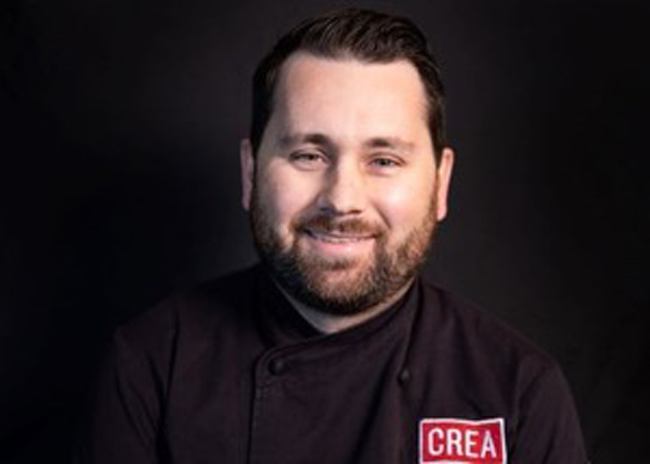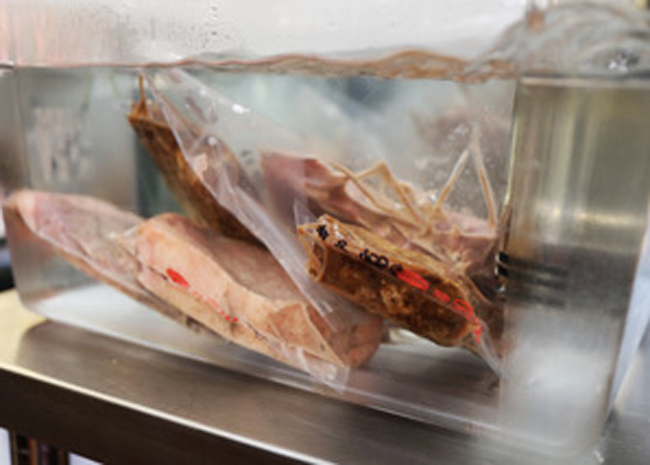With labor challenges continuing to plague the foodservice industry, operators are turning to various technologies to reduce staff, improve speed of service, cut down on food waste and otherwise streamline operations to save on costs.
 Robert CarkinOne such technology is sous vide cooking. Sous vide cooking is not a “new” technology by any means; Dr. Bruno Goussault is recognized as the founder of modern sous vide after pioneering cooking method in 1971 by vacuum sealing beef in a specially designed pouch and cooking it at slightly lower-than-usual temperatures in a circulating water bath. The result? A more tender and flavorful beef cooked with a consistent, hands-off approach.
Robert CarkinOne such technology is sous vide cooking. Sous vide cooking is not a “new” technology by any means; Dr. Bruno Goussault is recognized as the founder of modern sous vide after pioneering cooking method in 1971 by vacuum sealing beef in a specially designed pouch and cooking it at slightly lower-than-usual temperatures in a circulating water bath. The result? A more tender and flavorful beef cooked with a consistent, hands-off approach.
These days, operators can choose from multiple types of vacuum-sealing and sous vide machines. The Culinary Research & Education Academy, founded by Goussault, continues to educate chefs and foodservice operators about this cooking technology. It’s also becoming more widespread, says Robert Carkin, an executive chef for CREA. More health departments allowing the technology in commercial kitchens as long as there are suitable HACCP plans represents one reason for the recent growth in popularity. Cuisine Solutions, the parent company of CREA, which is the consulting arm of the business, even offers HACCP plan development for operators. Cuisine Solutions also offers sous vide training, equipment advice and a line of pasteurized, ready-to-use foodservice and pastry products prepared via sous vide in its production center.
“We’re getting more and more inquiries about HACCP plans from around the country,” says Carkin, and he understands why. “There are many benefits to sous vide cooking, whether you buy products from us or do it in-house.” Not to mention, sous vide equipment is available in electric and ventless form, which makes it easy to implement in non-traditional, hoodless settings. Here’s a look at three other top benefits.
Reduces Labor
Sous vide cooking essentially offers a set-it-and-forget-it option for operators. After properly vacuum sealing (Carkin recommends a commercial-grade vacuum chamber for foodservice operations), the pouches can be set in a water circulator or combi oven (more on that in a minute) at the recommended temperature for that type of food (e.g., chicken is 74 degrees C/165.2 degrees F). Sous vide technology also maintains consistent temperatures, unlike traditional cooking equipment, which can fluctuate.
Carkin recalls a recent sous vide rollout at a collegiate dining operation. “We were able to reduce one full-time employee. If operators want to focus on tangible dollars, it’s finding ways to reduce FTEs.” Carkin adds that while the industry is getting back to pre-pandemic levels as far as hiring goes, the talent level is not quite there yet, so leveraging technology helps.
Enhances Speed of Service
“From a customer standpoint, they’re always in a hurry,” Carkin says. In other words, the faster the service, the better.
Case in point: Operators can take a burger that’s been partially cooked and pasteurized via sous vide technology, pop it in a rapid cook oven and “cook it to medium-rare in just two minutes and 45 seconds every time, simply by hitting a button,” Carkin says. “If an operator does not want to invest in a circulator and already has a combi oven, we can work with them to program the combi to cook products like sous vide. We’ve been able to help clients cut their vegetable cooking times in half using this method.”
Operators can also use sous vide can for faster pastry production, Carkin says. “We process gallons of batter, package it in pouches, pasteurize it and freeze it.” The operator can then “grab as much as they need at a time and thaw batter for madeleines [cookies] in less than 20 minutes,” he says. Operators can also use sous vide technology to partially cook/pasteurize jarred desserts like creme brulee, puddings, cheesecake and cakes and ingredients like pastry cream for scratch-made desserts.
“This way, you don’t have to worry about dropping batter, burning cheesecakes or hitting a certain temperature for eggs because everything is already pasteurized,” Carkin says. “You can just take out the pouch, pipe it in a container and bake it off fresh.”
 Sous vide is a cooking method that vacuum seals meat in a specially designed pouch and then cooks it at slightly lower-than-usual temperatures in a circulating water bath.
Sous vide is a cooking method that vacuum seals meat in a specially designed pouch and then cooks it at slightly lower-than-usual temperatures in a circulating water bath.
Reduces Waste
Sous vide cooking can lead to greater yield and longer shelf life for menu items, Carkin adds. “The shelf life for sous vide products can extend up to seven days when thawed, up to three days when the pouch is opened, and up to 18 months from frozen,” he says. “Cooking in a water bath or at lower temperatures in a combi oven also cuts down on moisture loss, leading to greater yield.”
Carkin says as a result of this, many high-volume clients favor meats prepared sous vide and simply seasoned that they can use as a base for multiple menu items. “Chicken can be used as taco meat or in pasta dishes, or for a buffalo chicken dip,” he says.
Sous vide cooking can also be used to create cryoconcentrates. For example, Carkin has taken the peels and core from slicing pineapples, vacuum sealed the byproduct, and cooked it in a circulator and the result is a highly concentrated, natural flavor and sweetener that operators can use in cocktails, ice cream, sorbets, desserts and more. He’s done the same with trim from carrots and artichokes — even coffee grounds — to extract one more use of the ingredient before it goes into compost. “The flavor combinations and are endless when it comes cryo-concentrates,” he says.



